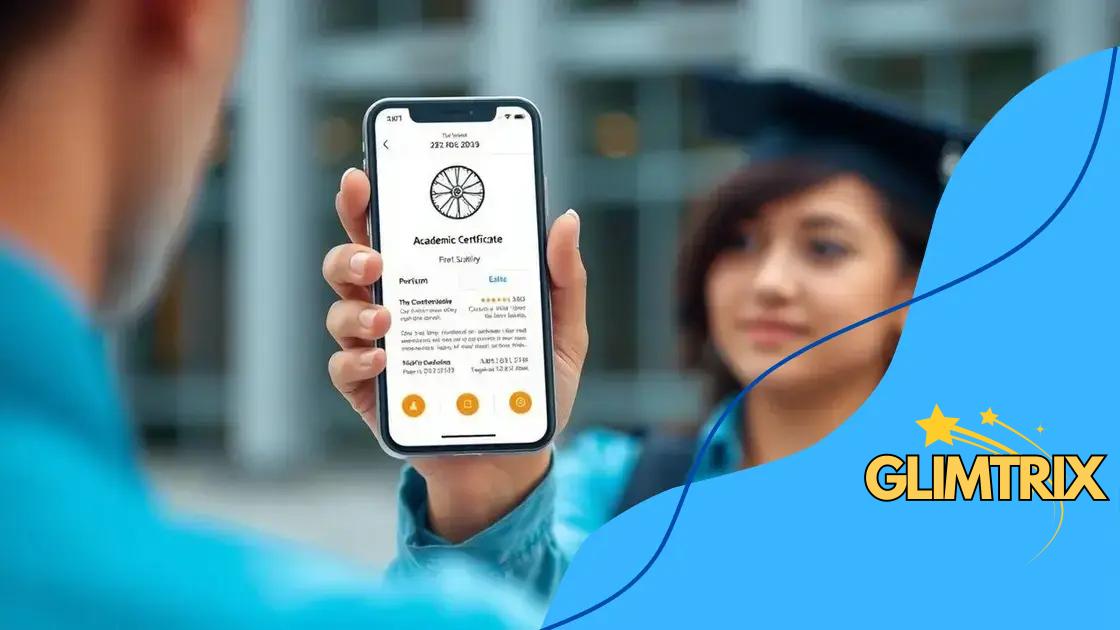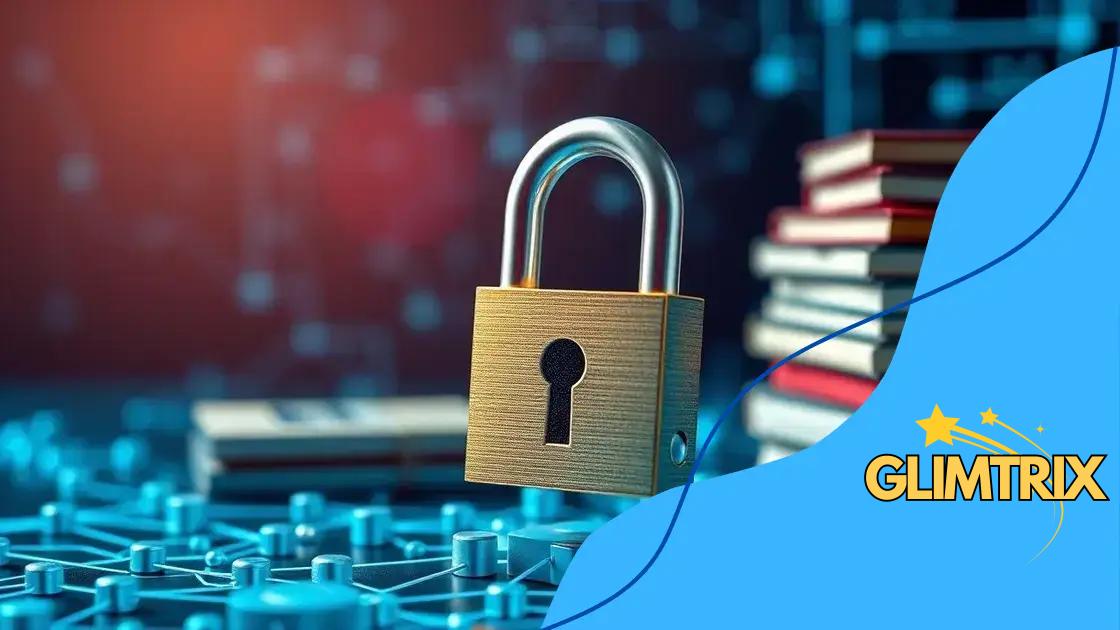Blockchain for academic record security: why it matters

Blockchain for academic record security ensures the integrity, accessibility, and verification of credentials, utilizing decentralized technology to prevent tampering while enhancing trust in the educational system.
Blockchain for academic record security is becoming a game-changer in how we manage and verify educational credentials. Have you ever wondered how secure your diploma really is? Let’s explore how this technology brings trust and transparency into the world of academics.
Understanding blockchain technology
When we talk about blockchain technology, it’s important to understand its core principles. Blockchain is a decentralized system that allows data to be stored across many computers, ensuring that no single entity has complete control. This makes it a powerful tool for various applications, including securing academic records.
What is Blockchain?
At its simplest, blockchain is a series of blocks linked together. Each block contains a set of transactions, and once a block is filled, it is added to the chain in a linear order. This system is secured using cryptographic methods, making it nearly impossible to alter past records without detection.
Key Features of Blockchain Technology
There are several key features that make blockchain unique:
- Decentralization: No single point of control, ensuring fairness and transparency.
- Immutability: Once data is added to the blockchain, it cannot be changed without consensus from the network.
- Transparency: All transactions can be viewed by participants, promoting accountability.
- Security: Advanced cryptographic techniques protect data integrity.
By leveraging these features, educational institutions can use blockchain to create secure academic records that are verifiable and tamper-proof. This eliminates the risks associated with traditional paper records, which can easily be lost or forged. Furthermore, students can have direct access to their records, allowing for quicker verification during job applications.
As we delve deeper into this technology, it’s clear that blockchain offers innovative solutions to traditional problems in record-keeping. By adopting this technology, educational institutions can pave the way for a future where academic integrity is maintained effortlessly.
Benefits of blockchain for academic records
The use of blockchain for academic records brings numerous advantages that enhance the security and reliability of educational credentials. One of the main benefits is the ability to securely store and share information without the risk of tampering.
Enhanced Security
With blockchain, academic records are protected through advanced cryptographic techniques. Once a record is added to the blockchain, it cannot be altered or deleted. This ensures that the integrity of the data is maintained, reducing the chances of fraud.
Improved Accessibility
Using blockchain allows students and employers to easily access verified records. This immediate availability can streamline processes such as job applications or further education. With just a few clicks, a potential employer can verify a candidate’s qualifications without dealing with lengthy paperwork.
Cost Efficiency
Adopting blockchain technology can also lead to cost savings for educational institutions. Traditional record-keeping systems require significant resources for maintenance and verification. On the other hand, a blockchain system automates many of these tasks, saving both time and money.
Transparency and Trust
Another key benefit of using blockchain for academic records is increased transparency. All transactions on the blockchain are visible to authorized users. This transparency promotes trust among students, institutions, and employers, creating a more straightforward verification process.
As universities and colleges adapt to modern technological advancements, implementing blockchain solutions can significantly enhance their efficiency and credibility. Adopting such innovations places institutions at the forefront of educational integrity, ensuring that they are prepared for the future.
How blockchain enhances record security

Blockchain technology plays a crucial role in enhancing record security for various sectors, especially in education. The unique features of blockchain contribute significantly to protecting sensitive information.
Decentralized Architecture
One of the primary reasons blockchain enhances record security is its decentralized nature. Unlike traditional databases stored in a single location, blockchain distributes data across a network of computers. This makes it much harder for malicious actors to alter or access the information without authorization.
Cryptographic Security
Each block in a blockchain is secured using cryptographic techniques. The data stored in these blocks is encrypted, ensuring that only authorized users can access or modify it. This encryption adds an additional layer of security, making unauthorized access nearly impossible.
Transparency and Auditability
Another significant benefit of using blockchain for record security is its transparency. All transactions on the blockchain are visible to participants who are granted access. This means that any alterations or updates to the records can be audited easily, promoting trust among users. When trust is fostered within an academic environment, many issues related to record verification and fraud diminish.
The combination of decentralization, cryptographic security, and transparency significantly improves record security in educational institutions. As schools and universities continue to adopt this technology, they can better protect student information and ensure that academic achievements are verifiable and trustworthy. Exploring the potential of blockchain not only strengthens security but also promotes a culture of integrity within educational systems.
Implementing blockchain in educational institutions
Implementing blockchain technology in educational institutions can seem daunting, but the benefits are worth it. Schools and universities can enhance record-keeping and improve the verification process of academic credentials.
Steps to Implement Blockchain
To successfully implement blockchain, institutions should follow a structured approach. Here are key steps to consider:
- Assess Needs: Determine what records and processes can benefit from blockchain integration.
- Select the Right Platform: Choose a blockchain platform that aligns with institution goals and technical capabilities.
- Engage Stakeholders: Involve faculty, administration, and IT staff to ensure everyone understands the benefits and functions of the new system.
- Conduct Training: Provide training sessions for staff and students on utilizing the blockchain system effectively.
As blockchain continues to evolve, its adaptability makes it suitable for various academic processes, from admissions to the issuance of diplomas. By decentralizing data storage, institutions can mitigate risks of data loss and fraud.
Challenges to Consider
While the advantages are substantial, institutions must also consider potential challenges when implementing blockchain technology. Some challenges include:
- Technical Complexity: Understanding how to best utilize blockchain can be complicated.
- Cost Concerns: Initial setup and ongoing maintenance costs may be a concern.
- Data Privacy: Ensuring compliance with data privacy laws is essential.
Implementing blockchain technology in educational institutions promises a safer, more efficient way to manage academic records. By approaching implementation thoughtfully, institutions can reap the rewards while overcoming potential obstacles along the way.
Future trends in blockchain usage for education
The future of blockchain usage in education is bright, as institutions around the world begin to recognize its potential. As technology evolves, several trends are likely to shape how educational systems utilize blockchain.
Increased Adoption of Smart Contracts
One of the most significant trends is the use of smart contracts. These are self-executing contracts with the terms of the agreement directly written into code. In education, smart contracts can streamline processes like enrollment and funding disbursements, making transactions faster and more secure.
Integration with Other Technologies
Another trend is the integration of blockchain with other emerging technologies, such as artificial intelligence and the Internet of Things (IoT). These technologies combined can enhance the educational experience, allowing for personalized learning pathways and real-time data analysis.
Blockchain for Micro-Credentials
Micro-credentials are quickly becoming a popular way to verify skills and achievements. Educational institutions are expected to use blockchain to issue digital badges and certificates that can be instantly verified. This trend will allow learners to showcase their skills more effectively, especially in fast-evolving industries.
Enhanced Data Privacy
As concerns about data privacy continue to grow, blockchain technology offers solutions that allow educational institutions to manage sensitive data securely. By decentralizing data control, institutions can provide students with more control over their personal information and how it is shared.
As we look ahead, the advancements and applications of blockchain in education will likely transform how we think about academic records and learning credentials. Staying informed about these future trends is essential for educators and institutions aiming to leverage technology for better outcomes.
FAQ – Frequently Asked Questions about Blockchain in Education
How does blockchain enhance security for academic records?
Blockchain uses decentralization and cryptography to ensure that academic records cannot be easily altered or tampered with, providing a secure environment.
What are smart contracts and how can they be used in education?
Smart contracts are self-executing agreements where the terms are written into code. They can automate processes like enrollment and payments in educational institutions.
What benefits do micro-credentials offer to students?
Micro-credentials provide a way for students to showcase specific skills. Using blockchain, these credentials can be easily verified by employers, enhancing job opportunities.
How can educational institutions start implementing blockchain technology?
Institutions should assess their needs, choose an appropriate blockchain platform, engage stakeholders, and provide training to ensure smooth implementation.





